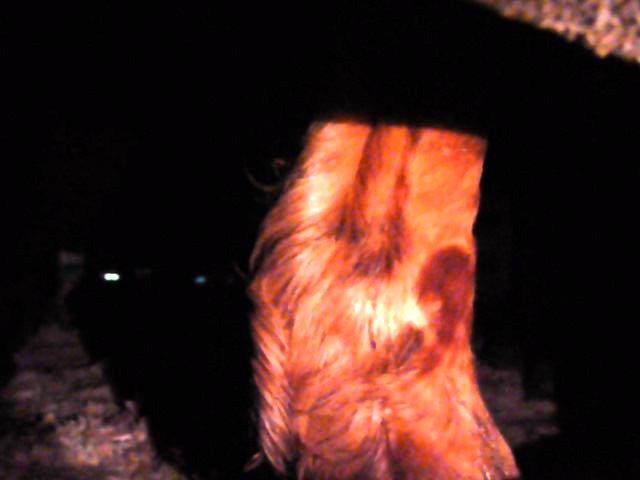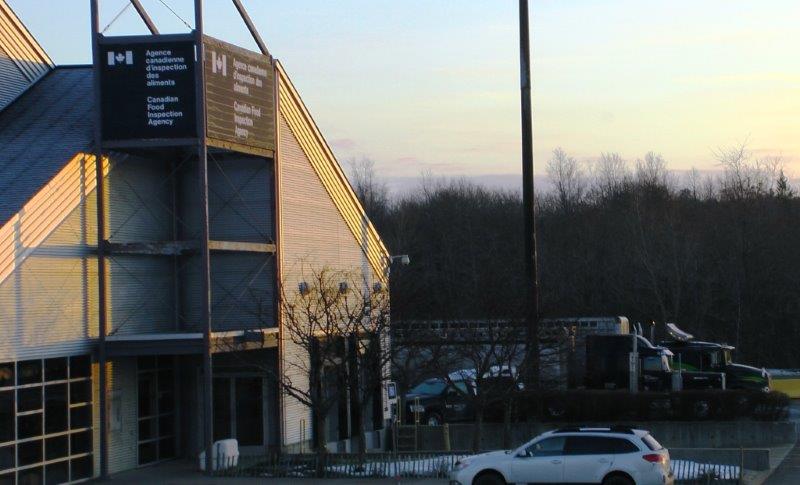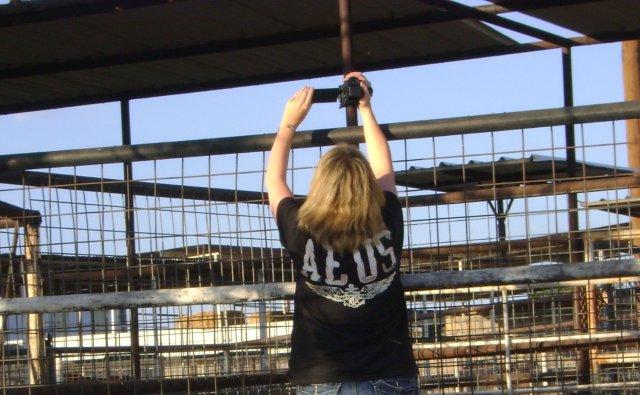|
|
At Animals' Angels we're grateful for the volunteers who help us with our investigations. One such volunteer was kind enough to share her first experience with AA and in turn we wanted to share it here with all of you. Below is an investigation from a volunteer's eyes.
My first encounter with Sonja Meadows, President of Animals' Angels, was over a downed Holstein cow at New Holland Sales Stables in 2007. She asked me where she could get water for the cow lying on the concrete in the hot sun. Sonja doesn't sit in a plushy office directing her employees. Having worked in Europe as an animal welfare investigator, Sonja came to the U.S. in 2006 with a mission. She takes the organization's motto "We are there with the animals" to heart--her dedication makes me proud to be a part of Animals' Angels.
When Sonja asked me to join her trailing killbuyer Bruce Rotz's trucks loaded with slaughter bound horses in January 2014, I hesitated. My workload was weighing on me and I did not relish travelling to Canada in the middle of a brutal winter. Sonja's response, "Then I'll have to go alone," changed my mind. I was off to trail a truck of horses to their brutal end in a Canadian horse slaughter plant.
As I prepared for the trip, Sonja advised to be sure and pack insulated coveralls and snow boots with traction in preparedness for the possibility of having to trek a distance to get a good view of the slaughter plants, and possibly for lying in the snow as we documented what we might be able to observe from a distance. This is one aspect I had not even considered and that's when I realized just how difficult and dangerous these investigations truly are.
I learned that the first consideration in trailing a long distance transport is determining when the truck may leave their location. One might think you simply park outside the property and hunker down in the middle of the night and wait indefinitely. Cop shows seem to always manage that with endless cups of coffee magically supplied to prevent drowsing off. The reality is that if you stay up all night or all day in hopes of not missing when the trucks leave, you will be too sleep-deprived to follow them for the 24 hour plus trip. You must make a calculated decision based on the situation. This is what Sonja has learned from many investigations and it is a vital skill to have for a successful trailing. If you start out tired or are observed by the killbuyer or neighbors as suspicious, the chances of covertly trailing the transport drop dramatically.
 | |
Rotz' property
|
Parked inconspicuously and drawing as little attention to ourselves as possible, Sonja and I waited in our car for hours outside of Rotz's property until we saw 3 horse transport trucks get on their way from his facility - with approximately 28 horses per truck, headed for a slaughter house in Canada. We decided to follow the first truck which left. And thus the arduous journey began.This experience also taught me that there is a strategy to trailing so as to avoid detection. It requires constant attention and no stops for coffee or bathroom breaks. Even when the trucker stopped, and he did every time he passed a well known fast food chain, we could not go in to buy the yearned for coffee, nor could we risk going into the restroom. As you know, coffee and restrooms go together. The trucker could refresh himself, while we had to position the car as stealthily as possible and wait for his return to the road. We had to be ready to move at a moment's notice.
At one such out of the way rest stop, Sonja decided it was an opportune time to check on the horses inside the trailer. While the driver was in the bathroom, I stood guard while she walked over to the trailer with a flashlight and camera to document the condition of the horses and to determine if they were all still standing. It was a highly risky endeavor since the driver could return any moment and confront her (and goodness knows what some of these guys are capable of). It made me very nervous because of the location, but as Sonja explained, it was an essential part of the investigation. Thankfully all of the horses were standing and Sonja returned to our car unnoticed. She made it back to the car just as the driver returned from the bathroom and we were on the road following the trailer once more.
 | | horse inside dark trailer |
It was a very foggy night in the mountains of northern Pennsylvania, though that did not slow the trucker. Onward through New York state until a few miles from the Canadian border where the trucker pulled off the highway and parked in an empty parking lot. We waited to see his next move. He never got out to check on his cargo. When it became obvious he was sleeping, we checked into a small, rundown motel within view of his truck.This was most definitely the sketchiest motel I had ever set foot in. I will not even describe what we found in the bathroom. Regardless, we knew we had to rest and laid down on top of the bed covers fully clothed (ready for the morning) and very tired. Sonja set the alarm for 4 hours of sleep and I silently groaned, asking myself why I agreed to this trip.When we got up at the sound of the alarm, Sonja's first move was to look out the window. The truck was gone. Urged by Sonja to move quickly, it was about 5:00 a.m. and very dark when I found myself racing up the same highway on which we had been travelling only hours before, the obvious route. We found the truck a few miles up the road, the driver enjoying a leisurely breakfast at a fast food restaurant.He arrived at the border with us on his heels. The driver we were following could have left Pennsylvania later in the day and driven straight through to the slaughterhouse with minimal stops. It is an 8 hour drive to the border. Why put the horses through more stress by sitting additional hours with no food or water in the freezing weather?
 | |
following truck
|
I could only imagine the misery and suffering of the horses in that trailer, and the callousness of the man driving them to the slaughter house--taking as much time as he pleased. Though they were destined to be killed, surely they needn't have suffered as much as they did before-hand?
All livestock trucks transporting animals are required to pull off into the area of the Canadian Food Inspection Agency. CFIA veterinarians inspected the transports--by leaning a ladder up against the trailer in order to climb up and peer through the upper, open slats. From that vantage point, how on earth could they see if a horse was blind, about to give birth, had a debilitating wound or was lame? I was shocked at the lackadaisical way these inspections were conducted.
 | |
Trucks at CFIA
|
When the truck we were trailing pulled back onto the highway, the driver apparently realized that he was being followed. He began driving fast around curves which was dangerous due to the possibility of the trailer tipping over as horses are thrown from one side to the other. Not to mention the stress for the animals and the risk of obtaining serious injuries. The obvious disregard for his cargo was distressing.Finally, we watched him pull into Viande Richelieu. We found a place to park where we could observe the unloading area with binoculars. We saw that there was a gap between the trailer and the dock -- the horses had to jump this gap as those behind them crowded them, a perfect opportunity for a horse's leg to fall between the truck and loading dock and be broken as the frantic horses behind were prodded into the plant. I was saddened to think that Viande Richelieu simply did not care if that were to happen.  | |
at Richelieu
|
After watching the precarious unloading, it was finally time to head home. It had been a difficult journey following the slaughter truck, as it was easy to put myself in the position of any of the 28 horses on that truck...being driven along in the bare-as-bones interior -- no straw, no water, no food...starving and thirsty and freezing and afraid. I had just witnessed first hand the inherent secrecy and cruelty of the horse slaughter business. It was an even more difficult journey back...knowing that hundreds more horses were passing us in the opposite direction.
What raised my spirits, and still does to this day, was to know that we had accomplished our mission; we had found the proof that transports to the Richelieu plant from the US exceeded 21 hours--a staggering 10 hours longer than claims made by the plant owner that all transports are shorter than 12 hours.
By providing this proof to EU officials and EU consumers, who up until then had only the plant owner's say so on the issue, our voices were heard on behalf of horses everywhere, revealing the stark truth behind this horrendous industry. Richelieu, Rotz, and all of the others can no longer hide behind false advertising campaigns and bogus reporting...once again Sonja has exposed their shady operations for what they are.
I have been an animal advocate for more years than I can remember. Of all my volunteer work, I'm most proud of my association with Animals' Angels. They get things done.
|
|
Just what does an investigation cost?
|
Our biggest goal at Animals' Angels is to be out in the field rigorously inspecting markets, slaughter plants, feedlots and livestock trucks as much as possible. The shocking results from our investigations have proven over and over again to spur positive change -- but we need your support to continue these projects!
Even operating on our shoe-string budget, investigations are costly ventures to undertake. But they are absolutely imperative if we want to help our fellow animals.
I hope we can rely on your help and support. Your generous donation would allow us to be in the field with the animals, to help comfort them, to tell their stories, and to ensure that those responsible for their suffering are held accountable.
Here is your opportunity to send us where the animals need us the most:
- Finance the inspection of a market
$100 will cover the fuel, equipment & supply costs for a single day
- Finance the inspection of a slaughter plant
$100 will cover the costs for one full day
- Finance the trailing of a livestock truck
$150 will cover the costs for one day of trailing
- Finance an entire investigation
$500-$4,500 depending on location & length of investigation
We are there to help the animals. By donating, you too can take a stand against cruelty and be there for the animals. These sensitive animals cry out for help and working together we will answer that call.
Together we can make a difference!
|
|
|
|
|
| Quick Links |
 

 
Animals' Angels is a 501(c)3 non-profit organization, all donations are tax deductible.
 | |
Sonja filming
|
Your support is crucial to continue our work and Animals' Angels counts on you. Help us be there for the animals.
|
|

Just by shopping through Amazon, you can help Animals' Angels investigations! A percentage of all sales will be donated to Animals' Angels. Please check out this promotion and share it with your friends. It has never been easier to donate!
|
|
About us
| |
Animals' Angels works to improve conditions for farm animals. We closely cooperate with law enforcement and government agencies to fight animal cruelty. Our investigators are out in the field nationwide, visiting auctions, feedlots and slaughter plants.
Contact
Animals' Angels, Inc.
PO Box 1056
Westminster, MD 21158
443-821-3343
www.animalsangels.org
info@animalsangels.org
|
|
|